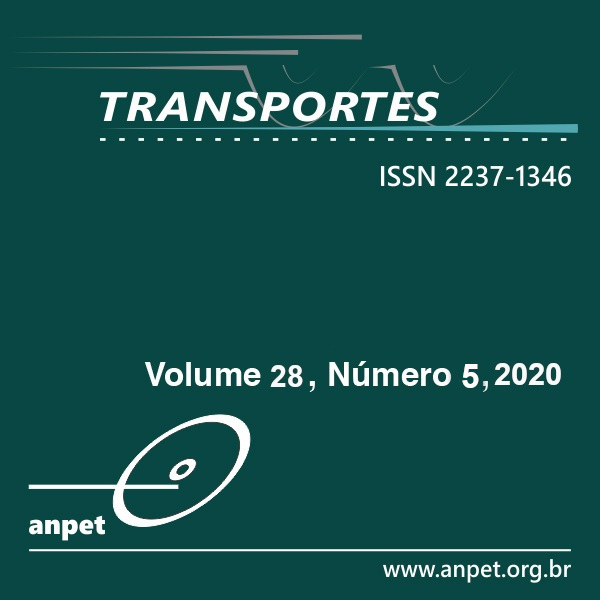Evaluation of database balancing techniques for road accident severity classification employing Artificial Neural Network
DOI:
https://doi.org/10.14295/transportes.v28i5.2271Keywords:
Imbalanced data. Accident severity. Classification and Artificial Neural Networks.Abstract
An inherent feature of road accident databases is the imbalance between the number of observations associated with accidents with fatal and non-fatal victims of injuries concerning to accidents without victims. This particularity led to the adoption of corresponding balancing techniques, which can resample classes and attributes. Therefore, it ensures that there is no over-adjustment of the data in classification problems. This study investigates the influence of different balancing methods such as undersampling, oversampling and SMOTE on the classification process of road accident severity adopting an Artificial Neural Network approach. The results obtained indicate that all methods used were able to effectively adjust the balance between the minority and majority classes. Balancing leads to a better performance of the classifier, shown by the efficient adjustment of the data to the model, as the gain in the quality and accuracy of the classification process, especially, considering sampling techniques such as SMOTE.
Downloads
References
Alejo, R.; Valdovinos, R. M. García, V. e J. H. Pacheco-Sanchez (2013) A hybrid method to face class overlap and class imbalance on neural networks and multi-class scenarios. Pattern Recognition Letters, v. 34, n. 4, p. 380–388. DOI: 10.1016/j.patrec.2012.09.003
Bolón-Canedo, V.; Sánchez-Maroño, N.; Alonso-Betanzos, A.; Benítez, J. M. e F. Herrera (2014) A review of microarray datasets and applied feature selection methods. Information Sciences, v. 282, p. 111–135. DOI: 10.1016/j.ins.2014.05.042
Chang, L-Y (2005) Analysis of freeway accident frequencies: Negative binomial regression versus artificial neural network. Safety Science, v. 43, p. 541-557. DOI: 10.1016/j.ssci.2005.04.004
Chang, L. e H. Wang (2006) Analysis of traffic injury severity: An application of non-parametric classification tree techniques. Accident Analysis & Prevention, v. 38, p. 1019–1027. DOI: 10.1016/j.aap.2006.04.009
Chen, C.; Zhang, G.; Qian, Z.; Tarefder, R. A. e Z. Tian (2016) Investigating driver injury severity patterns in rollover crashes using support vector machine models. Accident Analysis & Prevention, v. 90, p. 128–139. DOI: 10.1016/j.aap.2016.02.011
Delen, D.; Sharda, R. e M. Bessonov (2006) Identifying significant predictors of injury severity in traffic accidents using a series of artificial neural networks. Accident Analysis & Prevention, v. 38, p. 434–444. DOI: 10.1016/j.aap.2005.06.024
Facelli, K.; Lorena, A. C.; Gama, J. e A. C. P. L. F, Carvalho (2011). Inteligência Artificial: Uma abordagem de aprendizado de máqui-na. Rio de Janeiro: LTC. 378p.
Fawcett, T. (2016) Learning from Imbalanced Classes. Available in: https://www.svds.com/learning-imbalanced-classes/. Access: November/2018.
Fouladgar, M.; Parchami, M.; Elmasri, R. e A. Ghaderi (2017) Scalable Deep Traffic Flow Neural Networks for Urban Traffic Congestion Prediction. International Joint Conference on Neural Networks (IJCNN), p. 2251–2258. DOI: 10.1109/IJCNN.2017.7966128
Hosmer, D.W. e S. Lemeshow (2000) Applied logistic regression, 2nd Ed. John Wiley & Sons, New York.
Krawczyk, B. (2016) Learning from imbalanced data: open challenges and future directions. Progress in Artificial Intelligence, v. 5, n. 4, p. 221–232. DOI: 10.1007/s13748-016-0094-0
Li, J.; Fong, S.; Wong, R. K.; Mohammed, S.; Fiaidhi, J. e Y. Sung (2018) A suite of swarm dynamic multi-objective algorithms for rebalancing extremely imbalanced datasets. Applied Soft Computing Journal, p. 1–22. DOI: 10.1016/j.asoc.2017.11.028
Mussone, L.; Ferrari, A. e M. Oneta (1999) An analysis of urban collisions using an artificial intelligence model. Accident Analysis & Prevention, 31, v. 31, p. 705–718. DOI: 10.1016/S0001-4575(99)00031-7
Prati, R. C.; Batista, G. E. A. P. A. e M. C. Monard (2008) Curvas ROC para avaliação de classificadores [Internet]. IEEE Latin America Transactions. 2008; 6 (2): 215-222.Available from: http://ieeexplore.ieee.org/stamp/stamp.do?arnumber=4609920&isnumber=4609907
Salunkhe, U. R. e S. N. Mali (2016) Classifier Ensemble Design for Imbalanced Data Classification: A Hybrid Approach. Interna-tional Conference on Computational Modeling and Security (CMS 2016), v. 85, n. Cms, p. 725–732. DOI: 10.1016/j.procs.2016.05.259
Wang, C.; Qiu, C.; Zuo, X. e C. Liu (2014) An Accident Severity Classification Model Based on Multi-Objective Particle Swarm Optimization. IEICE Trans. Inf. & Syst., n. 11, p. 2863–2871 DOI: 10.1587/transinf.2014EDP7069
Yuan, J., Abdel-Aty, M., Gong, Y. e Q. Cai (2019). Real-time crash risk prediction using long short-term memory recurrent neu-ral network. Transportation research record, 2673(4), 314-326. DOI: 10.1177/0361198119840611
Downloads
Published
How to Cite
Issue
Section
License
Authors who submit papers for publication by TRANSPORTES agree to the following terms:
- The authors retain the copyright and grant Transportes the right of first publication of the manuscript, without any financial charge, and waive any other remuneration for its publication by ANPET.
- Upon publication by Transportes, the manuscript is automatically licensed under the Creative Commons License CC BY 4.0 license. This license permits the work to be shared with proper attribution to the authors and its original publication in this journal.
- Authors are authorized to enter into additional separate contracts for the non-exclusive distribution of the version of the manuscript published in this journal (e.g., publishing in an institutional repository or as a book chapter), with recognition of the initial publication in this journal, provided that such a contract does not imply an endorsement of the content of the manuscript or the new medium by ANPET.
- Authors are permitted and encouraged to publish and distribute their work online (e.g., in institutional repositories or on their personal websites) after the editorial process is complete. As Transportes provides open access to all published issues, authors are encouraged to use links to the DOI of their article in these cases.
- Authors guarantee that they have obtained the necessary authorization from their employers for the transfer of rights under this agreement, if these employers hold any copyright over the manuscript. Additionally, authors assume all responsibility for any copyright infringements by these employers, releasing ANPET and Transportes from any responsibility in this regard.
- Authors assume full responsibility for the content of the manuscript, including the necessary and appropriate authorizations for the disclosure of collected data and obtained results, releasing ANPET and Transportes from any responsibility in this regard.










